Dante's Peak (1997)
Disclaimer - This is going to be a geological overview of the movie Dante's Peak. I am not going to focus on the plot, the acting, the directing or anything of the sort. This is purely a scientific critique on the movie and one from my own mind, so do not take that into effect on whether or not you are going to like this movie. In "science fiction" movies the role of the science advisors are often outranked by the director or other people in the movie and the science gets left out. This means that the bad science of the movie is often not a result of a bad advisor. So do not take my critique of the science as a direct shot at the advisor.
Of all the Geological Movies that I have seen this is actually the most accurate that I can think of. This critique will be more of a confirmation and helpful understanding of the facts than a ripping apart of the movie to expose the plot holes. Now onto the geological review. I will also make some time notes so that you can coincide when that comment is for in the movie.
------------------------------------------------------------------
- Geological Critique -
- The Story Basis -
The basis for the story is actually the eruption of 1980's Mount Saint Helens, which was used as a backdrop for the erupted mountain at the end of the movie as well for a scene within the crater of the mountain. The current status of several other mountains located within the proximity of Mount Saint Helens also played a part in the science of the movie (University of Maryland).
- Columbian Eruption -
- The Eruptions Itself -
 0:01:30 - The first sequence of the movie depicts an eruption in a foreign country. The eruption results in a lot of damage and the girlfriend of the main character, Harry (Pierce Brosnan), dies. There are two main activities that are associated with this eruption, mud rain and lava bombs. Later we find out that these events took place 4 years before the events of the main story and in the country of Columbia. Since the movie was made in 1997, the latest this eruption could be is 1993, but it was likely earlier than that (time for writing the script). Also there are several possibilities for volcanoes in Columbia. The picture on right shows 6 of the major Columbian volcanoes (USGS). Going through them can help narrow down which eruption is depicted in the movie:
0:01:30 - The first sequence of the movie depicts an eruption in a foreign country. The eruption results in a lot of damage and the girlfriend of the main character, Harry (Pierce Brosnan), dies. There are two main activities that are associated with this eruption, mud rain and lava bombs. Later we find out that these events took place 4 years before the events of the main story and in the country of Columbia. Since the movie was made in 1997, the latest this eruption could be is 1993, but it was likely earlier than that (time for writing the script). Also there are several possibilities for volcanoes in Columbia. The picture on right shows 6 of the major Columbian volcanoes (USGS). Going through them can help narrow down which eruption is depicted in the movie:
Galeras - One of the most active of the volcanoes. The last major eruption was in 1886 but a smaller eruption did occur in 1993 which resulted in the deaths of several scientists. Although, the scientists died because they were sampling in the crater when it erupted. The main town near the volcano is Pasto about 18 km from the volcano, although there is a closer town about 11 km away. The scientists were killed or injured by lava bombs.
Dona Juana - Very little activity of this volcano. The only known historical eruption is an extended eruption from 1897 - 1906. Nothing since.
Purace - This is another of the more active volcanoes in the region with the most recent eruption in 1977. Although, very little information is recorded on this eruption and it was only classified as a VEI 2. This is not likely the eruption in the movie.
Huila - Last known eruption was around 1555. The only activity since is a constant steam column and hot springs.
Nevado del Tolima - Last known eruption was in 1943 with the last major eruption occurring 3600 years ago. The eruptions in the last 2 centuries have all been minor, but explosive.
Nevado del Ruiz - The last known eruption was in 1991, but the eruption in 1985 was one of the most devastating in South American history. The eruption completely buried the nearby town of Armero and cause lahars that traveled more than 100 km. In 1984, the early days of volcanic activity, there was no team of volcanologists that could be sent out, but by the time of the eruption a team was constructed that could go anywhere in the world (USGS).
So the most likely result for the eruption in the movie is the 1985 eruption of Nevado del Ruiz. A second possibility could be Galeras, since several scientist did die and it takes place in the right year, but the scientists that died were in the crater and it does not seem as dramatic or even as active as the volcano is portrayed in the film. That type of drama and activity more closely relates to Nevado del Ruiz.
- Columbian Eruption Products -
So now the question is, since the eruption is likely based on actual events, are mud rain and lava bombs typical of large scale eruptions and what are they anyway? First off, some definitions for volcanic ejecta:
Tephra - Is any air-fall material the gets erupted out of a volcano.
Lava Bomb (AKA Volcanic Bomb) - This is a lump of molten rock that gets shot up into the air and solidifies on its way back down. Typically they form aerodynamic shapes while in flight.
Mud Rain - Is rain that falls through or from an eruption cloud.
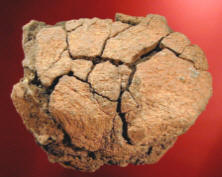 First off, the mud rain. When a volcano erupts with a large tephra cloud, the particles in the cloud act as water condensation points. This is essentially the beginnings of a rain cloud. These tephra clouds commonly produce rain with the tephra mixed in causing it to rain mud. So most eruptions, especially in humid climates will often have some if not a lot of mud rain (synapses.co.uk).
First off, the mud rain. When a volcano erupts with a large tephra cloud, the particles in the cloud act as water condensation points. This is essentially the beginnings of a rain cloud. These tephra clouds commonly produce rain with the tephra mixed in causing it to rain mud. So most eruptions, especially in humid climates will often have some if not a lot of mud rain (synapses.co.uk).
Volcanic bombs are named by the shape they produce. The shape is a result of viscosity of the magma, where the more viscous the magma the more defined the shape. Now very few of the bombs are visible in the movie but what we would expect from this type of eruption would be a bread-crust bomb (pictured right) which is most of what Mount St Helen's erupted. This is because the outside cools quickly but since there is so much gas and lava still on the inside, the bomb continues to expand, cracking the outer crust, and making it look similar to bread (gc.maricopa.edu).
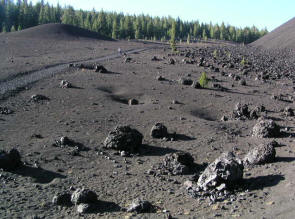 0:03:51 - So looking back at the movie if you look at the lava bombs that are actually visible, you can see most, if not all, of them have this general shape and appearance.
0:03:51 - So looking back at the movie if you look at the lava bombs that are actually visible, you can see most, if not all, of them have this general shape and appearance.
Now the variety of sizes in the movie include small ones, entirely possible, to ones large enough to destroy the front of the pickup truck. These lava bombs also hit things so hard as to leave major dents in them and even destroy the ground (or the pickup truck) where they land. In real life all these things can occur. Lava bombs can grow to become over 5 meters in diameter and can be shot several kilometers from the vent depending on the force of the eruption (Geotimes). Also, they are usually traveling at such a great rate of speed that they can damage and possibly destroy anything in their path (pictured left are impact holes) (LCC).
- Cascadian Background -
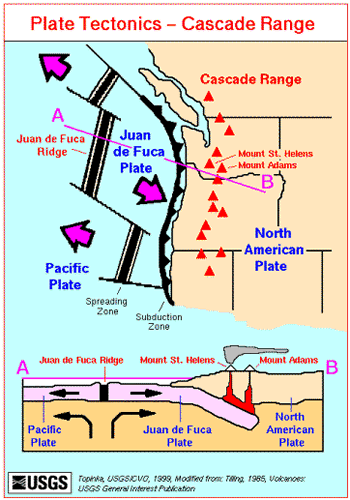 0:06:20 - The location for the movie is a mountain in the Cascade range monitored by the Cascades Volcano Observatory, specifically, a mountain in the state of Washington. The reason this region has so many volcanoes including Mount St Helens and Mt Rainier is due to the plate tectonics of the region. To simplify plate tectonics a little bit, this region is volcanic because of the proximity of a subduction zone. Simply put, this is where one plate goes beneath another plate and starts to melt. The melted rock then rises in the earth and forms the volcanoes (bottom picture to the right).
0:06:20 - The location for the movie is a mountain in the Cascade range monitored by the Cascades Volcano Observatory, specifically, a mountain in the state of Washington. The reason this region has so many volcanoes including Mount St Helens and Mt Rainier is due to the plate tectonics of the region. To simplify plate tectonics a little bit, this region is volcanic because of the proximity of a subduction zone. Simply put, this is where one plate goes beneath another plate and starts to melt. The melted rock then rises in the earth and forms the volcanoes (bottom picture to the right).
This type of area along continental edges forms volcanoes with explosive capabilities called "stratovolcanoes." This type of volcano produces the variety of eruption seen in the movie by Dante's Peak (the volcano). The reason the volcanoes are explosive is because of the type of magma that is erupting. Looking at the igneous rocks part of the website you can see there are 3 main types of rocks based on silica content. The less silica in the rock the more "mafic" it is and the hotter the rock is when it erupts. This magma is more common in volcanoes like Hawaii. The magma erupting in the Cascades has a higher silica content (felsic) causing it to cool faster, which results in an eruption consisting of more gaseous and solid material (San Diego State University Geology Department).
We will go in to the type and order of the eruption that is presented in more detail below, but just so you know we are basing this on the typical eruption of the area.
Also so you know the Cascades Volcano Observatory is a real place which was developed following the eruption of Mount St Helens, although it is located in Vancouver not Portland as mentioned.
- Pre-Eruptive Activity -
Several things happened in the movie before the actual eruption took place. This includes the lava eruption in the hot spring, the CO2 levels in the air, different types of earthquakes, and sulfur dioxide (SO2) in the water supply. Looking at these individually will help us to understand these processes a little better. This starts off with the reason that Harry is actually being brought out to Dante's Peak in the first place. These includes earthquakes which are located 10-20 km below the earth surface, prompting Harry to speculate that the chances for an eruption of the mountain are about 10,000:1.
- Initial Disturbances -
0:06:35 - The piece of paper that Harry is looking at is called a seismograph. I will go into that in a little bit but the main purpose is to show that there are earthquakes taking place under the volcano. They state that the earthquakes are about 10-20 km in depth. Earthquakes that deep are not usually a cause for alarm, but they do put up warning bells. The reason the great range could be one of two things. First there are several earthquakes which are occurring at about the same time, starting around 10km down and going down to about 20km. The other possibility is that since this volcano had such a high improbability of erupting (10,000:1) they did not have many seismographs in the region, which would prevent a highly accurate reading. The reason that the probability is 10,000:1 is likely due to the location of the volcano as well as previously recorded activity of the volcano.
- Hot Springs -
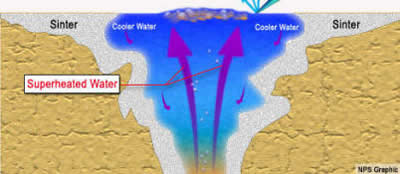 0:10:40 - So 2 young lovers decide to go skinny dipping in Twonset Hot Springs on the side of the volcano. Well apparently the volcano gods disapproved of this and caused an eruption to happen directly in the springs essentially boiling the couple alive instantly. The question is, do eruptions happen in hot springs before surrounding areas and what is the result of an eruption in a spring?
0:10:40 - So 2 young lovers decide to go skinny dipping in Twonset Hot Springs on the side of the volcano. Well apparently the volcano gods disapproved of this and caused an eruption to happen directly in the springs essentially boiling the couple alive instantly. The question is, do eruptions happen in hot springs before surrounding areas and what is the result of an eruption in a spring?
First off, how does a hot spring form? There are two types hot springs, ones in volcanically inactive regions and ones in volcanically active areas. In volcanically inactive areas, the spring water travels deep into the ground where the rocks are warmer (or radioactive) and then it travels back up into pools. This type of hot spring is present in Hot Springs National Park in Arkansas. In volcanically active areas, the water is warmed by the nearby magma (see diagram). Typically the water will obtain chemicals and minerals from the magma in the water causing the water to be: A. superheated from the magma and B. acidic from the minerals (USGS). Usually springs of this type are impossible for human use because of those two reasons. But if the water is not in direct contact with the magma it is possible for it to be heated from the rocks but not too hot for human use. And since the area where the water is being heated is close to the magma it is possible that the eruption would happen there before anywhere else.
So this scenario is possible, though it requires a rather shallow earthquake (which does not seem to be felt) to cause the magma to move upward into the water stream, which we did not see in the movie. Although it could have happened just previously. Also the magma should not have moved through the water that fast since the water would cause the magma to solidify on contact. This could be overcome if the magma had a lot of pressure behind it, which is possible since it is on the verge of eruption. Also afterwards the water seems to be highly acidic, which would cause the damage seen to the bodies. Though the likely cause of death was being boiled alive and the acidic concentration of the water was altered afterwards.
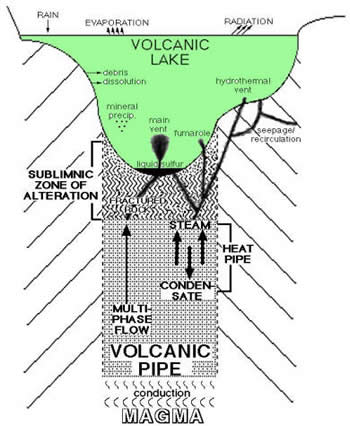 0:16:00 - When driving around the mountain Harry samples some of the pH levels of the lake. The readings come back at 3.48, which he then says he needs to compare to previous readings from that lake and Mount St. Helens. So the main question is, are acidic lakes common in volcanically active areas and how acidic is normal?
0:16:00 - When driving around the mountain Harry samples some of the pH levels of the lake. The readings come back at 3.48, which he then says he needs to compare to previous readings from that lake and Mount St. Helens. So the main question is, are acidic lakes common in volcanically active areas and how acidic is normal?
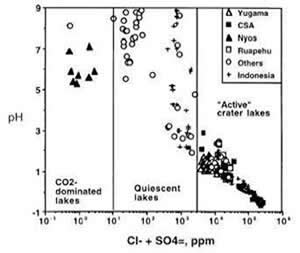 To understand what the pH of volcanic lake water should be we need to understand the pH levels of normal lake water. "Normal" pH levels should be around neutral (7) ranging about 6.5-7 (K12Science). In comparison, volcanic lakes are far from usual lakes since they are effected by all the chemicals and gases being released from the magma (picture to left). Also lakes with an active volcano would have an even lower pH because the gases that are released cause the pH to drop. This pH drop produces a downward trend where with the more active the volcano, the lower the pH level (pH graph below under "Active" crater lakes). The pH of a lake in a volcanically active region is commonly below 3 while the pH of a quiescent volcano ranges 2.5 and up (Pasternack.ucdavis.edu).
To understand what the pH of volcanic lake water should be we need to understand the pH levels of normal lake water. "Normal" pH levels should be around neutral (7) ranging about 6.5-7 (K12Science). In comparison, volcanic lakes are far from usual lakes since they are effected by all the chemicals and gases being released from the magma (picture to left). Also lakes with an active volcano would have an even lower pH because the gases that are released cause the pH to drop. This pH drop produces a downward trend where with the more active the volcano, the lower the pH level (pH graph below under "Active" crater lakes). The pH of a lake in a volcanically active region is commonly below 3 while the pH of a quiescent volcano ranges 2.5 and up (Pasternack.ucdavis.edu).
So according to this study the pH of the Dante's Peak lake is initially within normal limits of a quiescent volcano but it is too high for an active volcano. This is what the volcano actually should be at that moment in the movie. The only thing that would make this abnormal is if the normal readings for the lake were far higher previously, hence the reason he wanted to compare them to previous measurements.
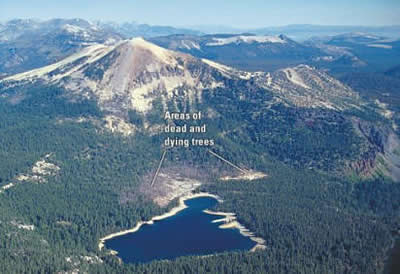 0:16:28 - In the movie several trees were killed off near a lake prompting the geologist to wonder how long they have been dead. He concludes that they were possibly killed due to high levels of CO2 released from the volcano. Does this happen in real life?
0:16:28 - In the movie several trees were killed off near a lake prompting the geologist to wonder how long they have been dead. He concludes that they were possibly killed due to high levels of CO2 released from the volcano. Does this happen in real life?
For a real life example lets look at the volcano Mammoth Mountain, which was an eruption false alarm (meaning it never erupted as expected). One of the reasons that scientists thought it was going to erupt was because of the dead trees in the area of the mountain (see picture). The reason the trees died was because high levels of CO2 in the soil killed off the roots of the trees, leaving the trees with nothing to feed with. The gas escapes from the magma in the volcano through cracks in the rocks explaining the large distance between the dead trees and the peak of the volcano in the picture. Since the CO2 is heavier than air it commonly gets trapped in snow banks, basements, and the soil surrounding a volcano (USGS). Just looking at the picture gives me an idea where the writers came up with their material for this scene. So in essence, yes this is also possible.
- Previous Activity -
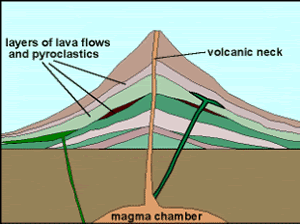 0:17:40 - Another thing that can tell a geologist just when an eruption is to be expected is the previous activity of the volcano. When Harry is driving around he is taking pictures and looking at the rocks on the flanks of the volcano. He then says that the last eruption occurred about 7,000 years ago. Of course he says this after looking at a rock on the volcano's flank, kind of giving the impression that he gained this knowledge from the rock, but that is information he would have known prior to driving out to the volcano in the first place.
0:17:40 - Another thing that can tell a geologist just when an eruption is to be expected is the previous activity of the volcano. When Harry is driving around he is taking pictures and looking at the rocks on the flanks of the volcano. He then says that the last eruption occurred about 7,000 years ago. Of course he says this after looking at a rock on the volcano's flank, kind of giving the impression that he gained this knowledge from the rock, but that is information he would have known prior to driving out to the volcano in the first place.
The picture to the left shows a cross section of a volcano. Scientists can determine how often a volcano usually erupts by dating each of these layers using a variety of methods. Now assume this is Dante's Peak, the top layer would be 7,000 years old. Now lets say the layers below that are 14,000, 21,000, and 28,000 years old respectively. Since each flow is about 7,000 years apart, a scientist would predict that a new eruption would be imminent. But since the eruption is a 10,000:1 likelihood (previously mentioned), we can assume that the next eruption would be predicted at several thousand to hundred thousand year from now.
- Current Activity -
0:20:33 - There are several classifications for the activity of a volcano. There are active, dormant, and extinct volcanoes, which all rely on when the most recent eruption was. Any volcano with an eruption within the last few hundred years is considered active, the last few thousand years is dormant, and nothing within the last few thousand years is extinct. Now a volcano can go from extinct to active anytime assuming the right conditions, but usually extinct volcanoes have a very little likelihood of erupting (OregonState). Calling this volcano dormant is correct since, as previously mentioned, the last eruption was only 7,000 years ago.
-Predicting Earthquakes -
0:20:33 - The scientists in the movie use many devices to help them determine that an earthquake is about to occur. These include a robot called "spider legs", as well as some of the information described above. But just because all the signs are there does not mean an eruption is imminent. Most eruptions cannot be determined 100% until they are actually occurring. This is the reason for the debate in the movie, which resembles real life debates surrounding many geologically active volcanoes.
- Costs of Bad Predictions -
There are usually 2 choices with 3 different results for a possible large eruption:
1. Don't do anything ![]() volcano does not erupt
volcano does not erupt
Result - Nothing, everyone is happy.
2. Don't do anything ![]() volcano has small eruption
volcano has small eruption
Result - Most people have time to get away and not much damage to property
3. Don't do anything ![]() volcano has big eruption
volcano has big eruption
Result - Huge loss of life and property because no one knew it was going to happen and so quickly.
One of two worst case scenarios
4. Cause an evacuation ![]() volcano does not erupt
volcano does not erupt
Result - Cost of everyone evacuating and loss of possible tourists, since now the area is a "threat". Bad politically, and the scientists look really bad too.
The other worst case scenario
5. Cause an evacuation ![]() volcano has small eruption
volcano has small eruption
Result - Everyone is safe and the town still looks like it has a larger problem than it really had. Not so good politically but better than nothing.
6. Cause an evacuation ![]() volcano has large eruption
volcano has large eruption
Result - Everyone happy because they are alive although huge loss of property. Best scenario after calling an evacuation for the scientists.
- Previous Predictions and Eruptions-
0:23:35 - Previous bad eruption calls are the main reason that Harry's boss, Paul, is so worried about a wrong call. He mentions that in 1980 he was sure that Mammoth Mountain was going to erupt, which it didn't, but the tourism and everything of the town was destroyed due to the bad call. As previously listed that was one of the worse case scenarios.
Mammoth Mountain is a real volcano located within the Long Valley Caldera of California. It is similar in composition to Mount St. Helens except that it has more of a basaltic magma (Oregon State). Most scientists figured that if the mountain were to erupt that the resulting eruption would be extremely minor. In 1980 the region was hit with four magnitude 6 earthquakes along with 25 cm of dome uplift of the caldera floor. In recent years more activity followed with groups of trees being killed (pictured in the - CO2 Gas Levels - section above) and more gas emissions (USGS). So it seemed likely that an eruption was possible in 1980, but I can find nothing about any evacuation of the region around that time.
Update (August 14th, 2012): I have been "recently" contacted by a couple of people (Micah Kipple and Craig Jones) commenting on my analysis of Mammoth Lakes so I figured I would go ahead and update that information. I may have been unclear before but in the movie it was never mentioned that an evacuation of Mammoth Lakes was called for. What is said is that Paul was in talks with the USGS in 1980 for a possible alert of the town when word was leaked that the USGS expressed concern so tourists stopped showing up and the town went bankrupt. This caused him to be much more cautious when it comes to putting a town on alert.
On the real life side of things, I was presented with more information regarding the possible alert that the USGS was actually putting on Mammoth Mountain (thanks Craig). One of my previous problems was that the year was wrong, which didn't help my search before. It turns out that the earthquakes under the mountain started in 1978 and continued through 1982 when the possibility of an alert by the USGS was discussed (Kerr, 1982). The USGS was in initial talks about the alert and didn't get the local government involved yet. The main problem was that the alert was leaked out by a reporter for the LA Times, who released the information just before the Memorial Day weekend causing concern before a local festival (The Free Library). This caused anger among the town's government who felt blindsided and caused tourism to decline rapidly. After the leaked story the USGS quickly issued their own alert, a notice of potential volcanic hazards, the lowest alert level (USGS Open-File Report 82-583, "Preliminary assessment of potential volcanic hazards in the Long Valley-Mono Lake area," by C. Dan Miller et al.), which described potential volcanic hazards and areas that could be effected. The alert levels increased as more earthquakes hit the town in 1983 but the mountain never erupted and it took the town several years to recover, all the while never forgiving the geologists who ruined their town. This event made the USGS rethink how they would issue alerts on volcanoes and dropped the system they were using shortly after in 1983 (NY Times).
0:34:25 - A comparison of Dante's Peak and Mount St. Helens prompted Harry to say that if the eruption was similar it would produce a blast that could reach the town within a minute. Figuring the Mount St. Helens blast accelerated to about 300 mph, and reached about 17 miles away from the mountain, this is entirely possible if it were to happen again (USGS).
0:45:39 - Another comparison that is made is to Mount Baker in the 1970's where it was thought that Mount Baker was going to erupt and never did. Mount Baker is another stratovolcano located in the North Cascades of Washington. In 1975 activity increased substantially causing much of the glaciers to melt off of the mountain. The activity involved was only a result of heat being released with no earthquakes associated with the event (USGS). So it is likely that most volcanologists never really considered this a threat for eruption back then.
- Gas Levels -
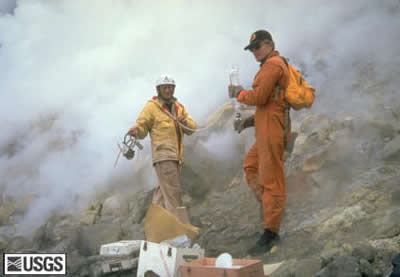 0:25:53 - Measuring the gases is another way to determine the possibility of eruption. Gas is emitted from the volcano in a variety of ways. The first one shown in the movie is gas bubbles in the lake. This is similar to the gas bubbles in the hot spring because there are cracks in the bedrocks that likely lead directly (or indirectly) to the magma. When the magma rises and releases the gas, the gas would be the first thing to reach the surface. Another way that gas is usually released is out of the top of volcano, which is the main vent for the gas.
0:25:53 - Measuring the gases is another way to determine the possibility of eruption. Gas is emitted from the volcano in a variety of ways. The first one shown in the movie is gas bubbles in the lake. This is similar to the gas bubbles in the hot spring because there are cracks in the bedrocks that likely lead directly (or indirectly) to the magma. When the magma rises and releases the gas, the gas would be the first thing to reach the surface. Another way that gas is usually released is out of the top of volcano, which is the main vent for the gas.
0:29:15 - As previously mentioned, measuring gas released from the vent is what they are doing by flying over in the helicopter and also with the robot in the volcano. In real life gasses can predict what is going on in a volcano. Usually when magma is deep in the earth the pressure keeps the gas within the magma but the closer to the surface it is, the more CO2 and SO2 is released from the magma out of the volcano. So as magma rises closer to the surface the gas concentrations in the atmosphere should also rise (PBS).
There are 2 ways to measure the gas released from a volcano. The first is what is seen in the movie, by collecting actual gas and measuring the concentrations of the different components (see picture to the right). As in the movie, the SO2 concentrations of Mount St. Helens were measured by a specially outfitted airplane. The second way is using a spectrometer which measures the light absorbed by the gas to determine the concentration of each type of gas (USGS). This method was not used by the movie. So their collection technique of flying in the helicopter should work at get a preliminary estimate, assuming the helicopter does not blow the air away from it. And even then, you still have the readings from the robot.
- Seismicity and Earthquakes -
 0:35:43 - One of the machines that is used to determine a possible eruption is a seismograph. This is a machine that measures the size, location and type of earthquakes that are being produced around the mountain and is the best test that a volcanologist can use (PBS). When Harry is using the seismograph he stamps the ground, which produces a mini earthquake that is read on the machine. He does this to determine if the machine is working or not. The resulting image is the same thing a real earthquake would produce just on a far smaller scale. The more seismographs you have surrounding the volcano, the more accurate a reading you can get on the epicenter (location) of each earthquake. There are two typical results produced on the seismograph, both of which are the pictured below. Each result is associated with one of two main types of earthquakes that associated with volcanoes.
0:35:43 - One of the machines that is used to determine a possible eruption is a seismograph. This is a machine that measures the size, location and type of earthquakes that are being produced around the mountain and is the best test that a volcanologist can use (PBS). When Harry is using the seismograph he stamps the ground, which produces a mini earthquake that is read on the machine. He does this to determine if the machine is working or not. The resulting image is the same thing a real earthquake would produce just on a far smaller scale. The more seismographs you have surrounding the volcano, the more accurate a reading you can get on the epicenter (location) of each earthquake. There are two typical results produced on the seismograph, both of which are the pictured below. Each result is associated with one of two main types of earthquakes that associated with volcanoes.
The first type is the most common in the world and it is referred to as a tectonic earthquake (USGS). This type of earthquake is the result of two sides of a fault being pushed passed one another (see picture on the right). Now when something gets stuck in between the 2 blocks (red circle) the movement stops. The strain between the two blocks builds and builds (think of trying to break a stick and its not breaking) until suddenly the thing holding the blocks in place breaks (the stick snaps) and the plates slide past each other quickly (see bottom picture on the right). That is why in most earthquakes the initial quake is the largest and following quakes (aftershocks) are smaller (top seismograph image below).
The other type of earthquake typical of volcanoes is called a harmonic tremor (NOVA). This is produced by magma moving through the volcano causing the ground to shake consistently (seismograph below). Kind of like shaking a bowl of Jell-O steadily.
Tectonic earthquakes are common around volcanic areas because the plates that typically produce the volcano in the first place are still moving. Like in the movie tectonic earthquakes are usually no indication of a possible eruption. But it is possible for the tectonic earthquakes to lead to harmonic tremors, or in other words the tectonic earthquake moves something in the earth, which allows the magma to move up through the volcano. So again the movie is faithful to the fact that the tectonic earthquakes could lead to harmonic tremors, which is a precursor to an eruption.
0:44:45 - The depth of the earthquake is also of great importance. The shallower the quake the close to the surface the cause is, and if it is magma, you know what that means (AVO).
- Volcano Robots -
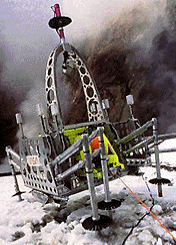 0:36:53 - So since pretty much being able to predict an eruption is a big deal, several tools are used. Paul mentions several different machines in the movie but the main one people notice is "Spider Legs", which is a robot used to go into the crater of the volcano where it is "unsafe" for the volcanologists. The robot is able to measure gas readings, temperature and even produce a video that can be watched back at the lab. In real life NASA has actually developed these things and tested them a couple of years before the movie. The robots were aptly name Dante I and Dante II (pictured on left). (I think the name Dante more refers to the voyage of the poet into Hell rather than the movie but that is just me)
0:36:53 - So since pretty much being able to predict an eruption is a big deal, several tools are used. Paul mentions several different machines in the movie but the main one people notice is "Spider Legs", which is a robot used to go into the crater of the volcano where it is "unsafe" for the volcanologists. The robot is able to measure gas readings, temperature and even produce a video that can be watched back at the lab. In real life NASA has actually developed these things and tested them a couple of years before the movie. The robots were aptly name Dante I and Dante II (pictured on left). (I think the name Dante more refers to the voyage of the poet into Hell rather than the movie but that is just me)
These robots were used for pretty much the same reason that they were in the movie, which was gas and water testing. Since most gas exuded from a volcano is heavier than air, the crater of the volcano could possibly be a toxic swimming pool of gas.
One final question to this section is, what is ELF and what does it stand for? ELF stands for extreme low frequency and we will get into it's capabilities a little later on.
- Earthquake Quantity -
0:37:17 - In the movie, during initial testing, the volcano is producing between 25 and 75 microquakes a day. The question is what are microquakes and are 25-75 really a common occurrence?
Microquake - Any quake that is below a 2 on the Richter Scale and is not detectable by a human on the surface.
Multiple microquakes in a short span of time in an active volcano is not all that uncommon. Volcanoes have been know to have more than 100 microquakes per day and still not be imminent for an eruption. Although it does cause concern and should be considered a strong warning sign (CBC).
- Changes in Size -
0:39:16 - Previously mentioned in the movie are laser beams that measure the amount of growth on the volcano. This can be produced in 2 ways. One is uplift of the crater floor and the other is actually producing what is called a lava dome. The growth of the crater bottom is also called bulging or swelling and lasers are not typically used in measuring this. Usually what is used is Electron Distance Meters (EDM), which uses infrared to bounce a beam off of the ground. This measures the change in distance between the sensor and the crater surface, similar to a laser but not quite. Some other methods include GPS which also can measure the change in height and tiltmeters which measure the change in angle of the surface (AVO).
Update (August 14th, 2012): I wanted to make a clarification point that was mentioned to me in an email by Micah Kipple. The crater floor is not the only part of the volcano that is being measure but most of the measurements are actually made on the flanks of the volcano. Not only are those areas easier to get to, provide a larger surface area to monitor, for could potentially give you safer and just as reliable results.
The material that forms a lava dome is from previous small eruptions. Studying the material can give a good indication of the type of material that might erupt from the volcano in the future. If the lava dome is currently growing that means that the volcano is actively erupting and releasing some of the stored pressure, which would reduce the likelihood of a violent eruption. So studying the dome would actually provide some valuable insight into what is going on in the volcano and what could be possible in the future.
- Contaminated Drinking Water -
0:51:00 - The penultimate event before the eruption is the presence of sulfur in the drinking water. Harry states the same thing happened at Mount Pinatubo in the Philippines before it blew it's top. The eruption that the movie is referring to is the 1991 eruption of the volcano, which is considered one of the most destructive in the 20th century altering global temperatures for years to come. It also produced the largest sulfur dioxide cloud since recording began in 1978. Although I can find no evidence of drinking water contamination for this particular eruption I have no doubt it possibly occurred. Like CO2, sulfur dioxide (SO2) can also be dissolved in the water, especially when it is present in large concentrations. So prior to an eruption there will be an increase in the gases released, which would likely contaminate the local drinking water supply (USGS).
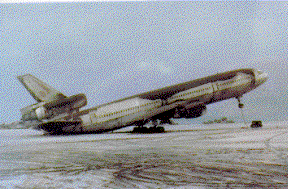 0:52:55 - Although predicting volcanoes is not an exact science, enough evidence can help make predictions more accurate. After deciding to actually evacuate the town they call several different people. These include the National Guard, the mayor, and the FAA. In real life these are the three groups that should actually be notified in case of an volcanic based evacuation. The mayor is the most obvious choice since she is the one to notify the townspeople. The National Guard is the second most obvious because in the case of any national disaster they are called to help regulate all evacuation procedures (FEMA). This was the case at Mount St. Helens as well (UCDavis).
0:52:55 - Although predicting volcanoes is not an exact science, enough evidence can help make predictions more accurate. After deciding to actually evacuate the town they call several different people. These include the National Guard, the mayor, and the FAA. In real life these are the three groups that should actually be notified in case of an volcanic based evacuation. The mayor is the most obvious choice since she is the one to notify the townspeople. The National Guard is the second most obvious because in the case of any national disaster they are called to help regulate all evacuation procedures (FEMA). This was the case at Mount St. Helens as well (UCDavis).
The last one is the one most people would not realize why. Volcanic ash clouds can be devastating to the propulsion system of airplanes, since ash is essentially microscopic particles of glass. These sucked into an engine can clog it up and tear it apart. Hence the reason the FAA should be one of the first to be notified so they know to adjust all air routes around the region (USGS).
- Eruption!!! -
- Types of Eruptions -
0:56:02 - First a little background on eruptions before we delve into the eruption itself. There are 5 main types of eruptions. Each type is indicative with a different level of activity and different eruptive materials (sdsu.edu).
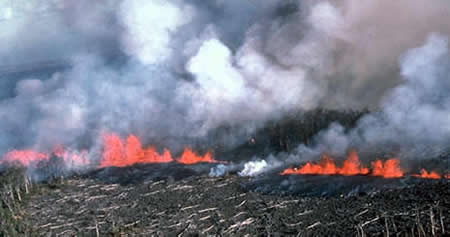 1. Fissure eruptions - Fissure eruptions come from cracks in the ground. The lava erupted usually is basaltic with a very low viscosity.
1. Fissure eruptions - Fissure eruptions come from cracks in the ground. The lava erupted usually is basaltic with a very low viscosity.
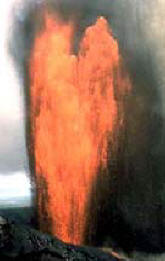 2. Hawaiian eruptions - Similar to fissure eruptions just on a larger scale. It produces very gentle eruptions with low viscosity lava that usually contains a sustained flow.
2. Hawaiian eruptions - Similar to fissure eruptions just on a larger scale. It produces very gentle eruptions with low viscosity lava that usually contains a sustained flow.
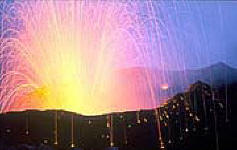 3. Strombolian eruptions - These are short lived eruptions that are usually more active than Hawaiian eruptions. The eruptions contains built up air, which causes the lava to be more viscous and louder but no more dangerous.
3. Strombolian eruptions - These are short lived eruptions that are usually more active than Hawaiian eruptions. The eruptions contains built up air, which causes the lava to be more viscous and louder but no more dangerous.
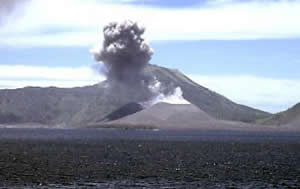 4. Vulcanian eruptions - These eruptions are more explosive then strombolian eruptions and involve a series of cannon like explosions followed by more subdued eruptions. The eruptive columns can reach about 5-10 km in height and but they produce only a small quantity of tephra (erupted material).
4. Vulcanian eruptions - These eruptions are more explosive then strombolian eruptions and involve a series of cannon like explosions followed by more subdued eruptions. The eruptive columns can reach about 5-10 km in height and but they produce only a small quantity of tephra (erupted material).
 5. Plinian eruptions - These eruptions produce an eruption with qualities that are similar to both Hawaiian and Vulcanian combined. This is because it produces an eruptive column like the Vulcanian eruption but it is sustained like the Hawaiian eruption. The lava that is erupted is usually felsic. The felsic lava cools quickly and usually erupts in solid form like ash and pyroclastic debris. These eruptions usually produce large quantities of tephra that blankets the surrounding region in pumice and ash.
5. Plinian eruptions - These eruptions produce an eruption with qualities that are similar to both Hawaiian and Vulcanian combined. This is because it produces an eruptive column like the Vulcanian eruption but it is sustained like the Hawaiian eruption. The lava that is erupted is usually felsic. The felsic lava cools quickly and usually erupts in solid form like ash and pyroclastic debris. These eruptions usually produce large quantities of tephra that blankets the surrounding region in pumice and ash.
- Analyzing the Eruption -
0:56:02 - Based on the main type of eruptions it is obvious that Dante's Peak produces a Plinian eruption (lots of material ejected and very very active). Since we know that, we can now analyze the Dante's Peak eruption in depth, to determine if the eruption seen is what would be seen in real life.
First the order of eruption at Dante's Peak:
Tectonic Earthquakes
Harmonic Tremors
Vertical Eruptive Cloud
Spreading of the Eruptive Cloud and Ash Fall
Lava Flow
Relative Calm
The Next Day
Lahars
Pyroclastic Cloud
Relative Calm
- Tectonic Earthquakes and Harmonic Tremors -
0:56:02 - These have already been discussed above so I will not delve into them too much again. Just remember tectonic quakes occur first, followed by harmonic tremors. The main question for this part is: do earthquakes continually occur with the eruption and if they do how large can they possible get. Study of the Mount Pinatubo eruption showed continuous seismic activity until either the signal was lost or the station was destroyed, indicating that yes activity does occur consistently with the eruption (USGS). The reason that the earthquakes are continual is because a variety of things are happening at the same time. Initially with an explosive eruption the explosion itself is usually powerful enough the shake the earth. Also the magma moving through the magma chamber and the neck of the volcano at an accelerated rate, which will cause stress on the surrounding rocks, producing earthquakes. So the combination of all that causes the entire region to shake, usually (MSNucleus).
With all this going on it does not seem unlikely that the eruption is capable of destroying a town with just the earthquakes alone, especially a town not designed to withstand such earthquakes. So what is the size of the eruption that is associated with a particular earthquake? The eruption of Mount St. Helens was associated with a 5.1 earthquake, which is generally large enough to be felt but does not cause much damage (USGS). This is hardly large enough to cause the damage seen in the movie even close to the mountain. But Mount Pinatubo's eruption, the 2nd largest in the 20th century was associated with a magnitude 7.8 earthquake, which falls in the range of major destruction (About). So a relatively small eruption on the scale of things, Mount St. Helens, would not produce the damage seen but when you increase the destructive power to even halfway between Mount St Helens and Mount Pinatubo you get in the range of Dante's Peak destruction (UNR). So yes, town destruction by earthquake is possible.
 0:56:30 - The eruption of Dante's Peak can be thought of in two parts with the first part occurring here (0:56:30) in the movie and the second part occurring on the second day of eruption. This is a similar pattern as was seen at Mount Pinatubo which contained 4 eruptive columns on the first three days then a sustained 9 hour eruptive column the 4th day (USGS).
0:56:30 - The eruption of Dante's Peak can be thought of in two parts with the first part occurring here (0:56:30) in the movie and the second part occurring on the second day of eruption. This is a similar pattern as was seen at Mount Pinatubo which contained 4 eruptive columns on the first three days then a sustained 9 hour eruptive column the 4th day (USGS).
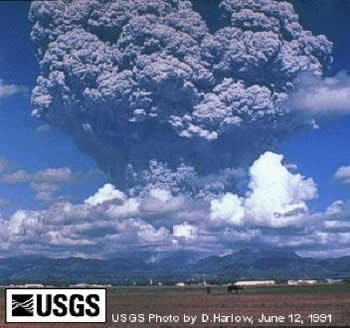 Most stratovolcanoes are thought to begin an eruption with a vertical eruptive column. This is similar to firing off a gun. The volcano finally releases all that steam that has been building up with blowing the top off the mountain, so that all the pent up pressure is going to push the contents of the mountain straight up. The picture of Mount St. Helens to the left shows this vertical plume cloud, while the picture on the right shows the Mount Pinatubo eruption which forms less of a plume and more like a reverse funnel. The Mount Pinatubo picture is from the first eruption of the 4. But still it contains the basic premise that all the material is going to be directed upwards. This first eruption is, as they put it in the movie, "just clearing it's throat."
Most stratovolcanoes are thought to begin an eruption with a vertical eruptive column. This is similar to firing off a gun. The volcano finally releases all that steam that has been building up with blowing the top off the mountain, so that all the pent up pressure is going to push the contents of the mountain straight up. The picture of Mount St. Helens to the left shows this vertical plume cloud, while the picture on the right shows the Mount Pinatubo eruption which forms less of a plume and more like a reverse funnel. The Mount Pinatubo picture is from the first eruption of the 4. But still it contains the basic premise that all the material is going to be directed upwards. This first eruption is, as they put it in the movie, "just clearing it's throat."
- Spreading of the Cloud and Ash Fall -
1:01:13 - After the initial plume, the plume in the movie starts to spread out into an all encompassing cloud, which causes ash to fall like snow everywhere. Typical eruptions will start to form a mushroom cloud with the plume still pushing up from the middle. The ash cloud that forms is the result of this mushroom cloud, which often blankets the neighboring region in ash as is seen in the movie. Larger eruptions would not have resulted in an ash cloud forming that quickly after the eruption, but assuming that this first eruption is smaller, it could produce a faster forming ash cloud, since there is not as much force pushing up on the cloud. So the closer you get to the peak the heavier the ash fall is going to be, hence the reason when the kids go up the mountain they are always in a thicker ash cloud than Harry, who is further down.
1:04:48 - See calling the FAA (previously mentioned in - Final Evacuation - section) on the results of flying through an ash cloud.
1:07:07 - See the mud storm (previously mentioned in the - Columbian Eruption Products - section) to see the effects of putting all that ash into the atmosphere. Volcanic eruptions are almost always associated with their own generated thunderstorms, including lightning.
- Lava Flow -
1:09:12 - This is when things start to stray from what might actually happen. As mentioned above there are several different types of eruptions but they can be grouped into two main ones. Eruptions that produce lava and eruptions that produce ash and pyroclastic debris. Most eruptions will not produce both because there are 2 different mechanisms for doing that. Some pyroclastic eruptions are capable of producing lava, although the lava that they produce never would flow as fast as seen in the movie (UCCS). The fast flowing lava is basaltic lava while this volcano would probably have felsic lava, which would flow more like thick molasses down the mountain. People could walk away from felsic lava and still be ok.
So this is the one major thing I can find wrong with the movie.
- Mirror Lake -
 1:11:04 - We have already discussed the initial concept of acidic lakes above with the measurements Harry did at the beginning of the movie (see the - Acidic Lake Levels - section). Now we will go into the extent of how acidic is it possible for a lake to get and is this strong enough to melt a metal boat?
1:11:04 - We have already discussed the initial concept of acidic lakes above with the measurements Harry did at the beginning of the movie (see the - Acidic Lake Levels - section). Now we will go into the extent of how acidic is it possible for a lake to get and is this strong enough to melt a metal boat?
The chart to the right shows how acidic a lake can get in an volcanically active region. The pH ranges from 3 down to almost -1 which is highly acidic (UCDavis.edu). Since the most common gasses in volcanic regions are CO2 and SO2 the likely acids in the lake are sulfuric acid and hydrochloric acid. 33% sulfuric acid is used as battery acid and contains a pH of about 0.5 while 90% sulfuric acid has a pH of about 0.1 (NIOSH). Both of these acids are commonly used to clean rust off iron and steel and other things (called pickling) although this does not result in the metal melting (Encyclopedia). So if this boat was to dissolve we would have to assume that the boat is not made of iron or steel, which is entirely possible. So the most common boat material, which is still metal, is aluminum. Luckily for us aluminum is able to be dissolved by hydrochloric acid, especially acid with a very low pH (Wisconsin.edu).
So it is entirely possible to melt an aluminum boat in the acid of a volcanic lake. The only problems we have here have more to do with dramatic effect than with the actual scientific content of the movie. This involves why the fish don't dissolve. Also why does the metal on the propeller melts before the plastic bearings, especially since the motor was agitating the water. This would have caused the whole thing to dissolving much faster then the rest of the boat. And finally, why when Harry's hand is splashing the acid everywhere while he is paddling does less damage occur to his arm than when Granny jumps in the water. Although she did end up with the appropriate amount of burn as she should have been.
- The Next Day -
- Lahars -
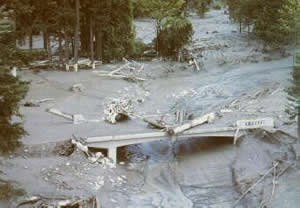 1:18:48 - So now we get the lahars. First off, what is a lahar? It is a rapidly moving mixture of rock, debris and water originating on a volcano (pictured on left). They form from large amounts of rainfall, the rapid melting of snow and ice off the volcano, or displacement of crater lakes (USGS). So far so good, this seems to be exactly what is happening in the movie. The volcano warms up the snow and ice built up on the volcano and sends it down into the town as a lahar. Lahars can develop anytime after an eruption, but usually due to rainfall from the eruption itself the lahar usually occurs soon after. The rainfall then mixes with the ash in the air and on the ground and forms this debris flow with the density of concrete.
1:18:48 - So now we get the lahars. First off, what is a lahar? It is a rapidly moving mixture of rock, debris and water originating on a volcano (pictured on left). They form from large amounts of rainfall, the rapid melting of snow and ice off the volcano, or displacement of crater lakes (USGS). So far so good, this seems to be exactly what is happening in the movie. The volcano warms up the snow and ice built up on the volcano and sends it down into the town as a lahar. Lahars can develop anytime after an eruption, but usually due to rainfall from the eruption itself the lahar usually occurs soon after. The rainfall then mixes with the ash in the air and on the ground and forms this debris flow with the density of concrete.
My only problem is that shouldn't the source of the lahar, the ice and snow, have melted the previous day with the scorching hot lava flows and all the heat being released from the volcano then? Like I said, most lahars are produced by rainfall, like the Mount Pinatubo eruption, but many are produced by melting, which includes Mount St. Helens. Unfortunately, we can not compare this one to the Mount St. Helens eruption, since that was a one time, blow your top, eruption, not an extended eruption like this one (SDSU). Also, since this crater does not have a lake that is not a possible source, although it does mix with a dammed lake further down the mountain which increases its outflow (size). So unless the lava flows were isolated to just the region that Harry was in before and not along the entire top of the mountain, and assuming that when it erupted the eruptive material only came out one side vent of the volcano, instead of the top, then this scenario is possible. Even still, most of the snow and ice should have melted the previous day with the eruption and the gas and ash released. So, I give this as another problem with the movie.
- Pyroclastic Cloud -
 1:27:30 - So finally we have the last major eruption of the mountain. This produces the pyroclastic debris flow, which is usually the most destructive part of a volcanic eruption. The cloud consists of high density, hot and dry rock fragments and volcanic gases, which can move at over 200 kph and range up to 700oC. The cloud is usually so hot that it can burn anything in it's path instantly (USGS).
1:27:30 - So finally we have the last major eruption of the mountain. This produces the pyroclastic debris flow, which is usually the most destructive part of a volcanic eruption. The cloud consists of high density, hot and dry rock fragments and volcanic gases, which can move at over 200 kph and range up to 700oC. The cloud is usually so hot that it can burn anything in it's path instantly (USGS).
Pyroclastic clouds form from the eruption cloud that is spewed into the air. The eruption cloud then forms into a mushroom shape, which eventually collapses. This collapsed structure is what forms the leading edge of the pyroclastic debris flow. The debris flow consists of two parts, the basal part, which contains the rock debris, and the upper part, which contains the gas and ash. The formation of the debris flow can occur within seconds of the eruption and completely decimate everything in its path (USGS). So in Dante's Peak the formation of the pyroclastic flow occurs pretty much exactly as it is seen in real life.
The speed that these can move varies widely with each volcano and even within each debris flow but typically the speed ranges between 80 and 200 kph, which corresponds to about 50 to 125 mph. So a truck driving away from these can escape a slow moving pyroclastic flow, but can a truck with no tires escape? Well essentially, they are already halfway across town when the pyroclastic flow started and they could likely move at least 20/30 mph, so I see no reason that this is not plausible at all. Their main goal was to try and get to the mine, which they reach, just when the pyroclastic flow arrived. This is seemingly impossible but when it is laid out I think they could have done it.
- Rescue -
1:30:48 - ELF: Again this stands for Extremely Low Frequency and is commonly used by the US navy to communicate with submarines. Typically, to generate a signal using ELF the government needs an antenna at least 14 km long. Since there is usually not a 14 km long antenna on a submarine, they could not produce the signals. So submarines were designed to only receive signals via ELF, then they would rise to the surface to receive more complicated messages using another form of communication (INCHEM). This does not seem practical for the movie's plotline, although the reason it was used was because it could transmit through large amounts of water (and possibly land). As recently as 1993 the Navy was still discussing using a 10km long antenna to generate ELF signals in Alaska. Even then, 10 km is far longer than the equipment they were using, generating what we like to call a "plot hole". This "plot hole" is essentially busted unless change what is used to one of the other billion gadgets that can do the exact same thing they want to do in the movie without using ELF (GlobalPolicy).
- Scientific Input -
1:42:56 - The scientific advisors for the movie are John P. Lockwood, David H. Harlow, and Norman MacLeod. I feel they did a good a job conveying the scientific accuracy of the movie and still maintaining an exciting movie feel. Dr. Lockwood started his own volcanic hazard consulting firm, Geohazards Consultants International, Inc. (ZoomInfo). The only information I can find on Dr. Harlow is that he is the photographer of the first day of the Mount Pinatubo eruption (pictured in the - Vertical Eruptive Cloud - section). And Dr. MacLeod is actually a paleontologist who studies the causes of extinctions and evolutionary patterns (MegaFoundation). So overall, from what I can find on at least two of the advisors it shows that they are pretty good volcanologists to have as consultants.
- Dante's Peak (The actual volcano) -
0:06:47; 0:25:30 - What was visualized for the actual view of Dante's Peak (the volcano) varied throughout the movie. The initial view that they first used was a model that they built and superimposed behind the town, via the miracle of movie magic. This is what was used for most of the movie, except during up close-up views. For the close-ups, when they were flying over the volcano, and along the crater edge they used video of Mount St. Helens. The way they filmed the volcano, both with the model and with Mount Saint Helens, was done so well that usually one could not tell if the volcano was real or not.
- Some questions asked (and hopefully answered) above -
-
Which volcano and eruption is depicted in the first sequence of the movie?
-
Are mud rain and lava bombs typical of large scale eruptions and what are they anyway?
-
Do eruptions happen in hot springs before surrounding areas and what is the result of an eruption in a spring?
-
Are acidic lakes common in volcanically active areas and how acidic is normal?
-
Do trees get killed off near an active volcano in real life?
-
What is ELF and what does it stand for?
-
What are microquakes and are 25-75 really a common occurrence?
-
What is the size of the eruption that is associated with a particular earthquake?
-
How acidic is it possible for a lake to get and is this strong enough to melt a metal boat?
-
What is a lahar?
- Overview (or important thoughts to take home) -
-
This is one of the most scientifically accurate geology movies out there
-
The most likely eruption at the beginning of the movie is the 1985 eruption of Nevado del Ruiz placing the remaining events of the movie in 1989
-
This conflicts with his mentioning of Mount Pinatubo which erupted in 1991
-
The Cascadian Range has lots of volcanoes that can produce this type of eruption
-
Signs of an impending eruption: Increased amount of gas released, increased earthquakes especially harmonic tremors, lava dome growth and increase is acidity of local water sources (lakes, hot springs, etc.)
-
Predicting actual eruptions is hard
-
The Dante's Peak eruption would not have produced that kind of lava flow
-
An aluminum boat would melt in an acidic volcanic lake but so would the fish and the entire motor rather quickly
-
My personal opinion places the lahar on the first day of eruption since most of the ice and snow should already have melted
-
The pyroclastic cloud occurred almost exactly as it would in real life, showing that it is the most dangerous part of a volcanic eruption
-
ELF is a fabrication of the movie because any real-life ELF transmitters have at least a 10km long antenna
- Non-Geological Notes -
-
In all that ash why are none of the people wearing anything over their mouths? You would think that would be the first thing you did.
-
So why doesn't Grandma wait until she is 3 feet from shore to jump into the lake when it truly was not necessary. Oh wait, she did.
-
Driving on a fresh lava flow? Other than fun, the truck would probably blow up before you even got 1/2 way across.
References Used and/or Cited
All links were up to date and working as of August 14, 2012
http://www.geol.umd.edu/pages/facilities/lmdr/dante/dante.htm
http://vulcan.wr.usgs.gov/Volcanoes/Colombia/Maps/map_colombia_volcanoes.html
http://www.volcano.si.edu/world/volcano.cfm?vnum=1501-08=
http://www.volcano.si.edu/world/volcano.cfm?vnum=1501-07=
http://www.volcano.si.edu/world/volcano.cfm?vnum=1501-06=
http://vulcan.wr.usgs.gov/News/MSH2004/VEI_information.pdf
http://www.volcano.si.edu/world/volcano.cfm?vnum=1501-05=
http://www.volcano.si.edu/world/volcano.cfm?vnum=1501-03=
http://www.volcano.si.edu/world/volcano.cfm?vnum=1501-02=
http://vulcan.wr.usgs.gov/Volcanoes/Colombia/Ruiz/description_eruption_lahar_1985.html
http://www.geology.sdsu.edu/how_volcanoes_work/Tephra.html
http://volcanoes.usgs.gov/images/pglossary/bomb.php
http://www.synapses.co.uk/science/mvolcano.html
http://www.gc.maricopa.edu/earthsci/imagearchive/bombs.htm
http://www.lcc.ctc.edu/departments/natural_sciences/pictures/archive/image_wk102404vbombs.xtm
http://www.geotimes.org/nov07/article.html?id=feature_danger.html
http://www.geology.sdsu.edu/how_volcanoes_work/Controls.html
http://www.nps.gov/yell/naturescience/hotspring_works.htm
http://vulcan.wr.usgs.gov/Glossary/PlateTectonics/Maps/map_plate_tectonics_cascades.html
http://vulcan.wr.usgs.gov/CVO_Info/framework.html
http://vulcan.wr.usgs.gov/Glossary/ThermalActivity/description_thermal_activity.html
http://www.k12science.org/curriculum/waterproj/F99project/F99discussion/1.html
http://pasternack.ucdavis.edu/lakes.html
http://pubs.usgs.gov/fs/fs172-96/
http://wapi.isu.edu/EnvGeo/EG6_volcano/volcanoes.htm
http://volcano.oregonstate.edu/
http://volcano.oregonstate.edu/vwdocs/volc_images/north_america/california/long_valley.html
http://lvo.wr.usgs.gov/index.html
http://pubs.usgs.gov/fs/2000/fs036-00/
http://vulcan.wr.usgs.gov/Volcanoes/Baker/description_baker.html
http://www.pbs.org/wgbh/nova/vesuvius/predict.html
http://vulcan.wr.usgs.gov/Volcanoes/MSH/Publications/EIB84/EIB84.html
http://www.avo.alaska.edu/about/operations.php
http://www.pbs.org/wgbh/nova/volcano/chouet.html
http://earthquake.usgs.gov/learning/animations/
http://acts.grc.nasa.gov/experiments/demos.shtml
http://www.cbc.ca/canada/british-columbia/story/2007/10/25/bc-microquake.html
http://www.slopeindicator.com/instruments/tilt-portable.html
http://pubs.usgs.gov/of/1997/of97-262/of97-262.html
https://www.geology.ucdavis.edu/~cowen/~GEL115/volcs2.html
http://www.fema.gov/emergency/nrf/glossary.htm
http://libraryphoto.cr.usgs.gov/cgi-bin/show_picture.cgi?ID=ID.%20Casadevall,%20T.J.%2015
http://volcanoes.usgs.gov/ash/trans/aviation_threat.html
http://www.geology.sdsu.edu/how_volcanoes_work/Eruption_types.html
http://www.geology.sdsu.edu/how_volcanoes_work/Fissure.html
http://www.geology.sdsu.edu/how_volcanoes_work/Hawaiian.html
http://www.geology.sdsu.edu/how_volcanoes_work/Strombolian.html
http://www.geology.sdsu.edu/how_volcanoes_work/Vulcanian.html
http://www.geology.sdsu.edu/how_volcanoes_work/Plinian.html
http://www.geology.sdsu.edu/how_volcanoes_work/Thumblinks/Curtainoffire_page.html
http://www.geology.sdsu.edu/how_volcanoes_work/Thumblinks/Tavurvur_page.html
http://pubs.usgs.gov/pinatubo/wolfe/
http://www.msnucleus.org/membership/html/k-6/pt/hazards/5/pth5_3a.html
http://pubs.usgs.gov/fs/2000/fs036-00/
http://geography.about.com/od/globalproblemsandissues/a/pinatubo.htm
http://www.seismo.unr.edu/ftp/pub/louie/class/100/magnitude.html
http://vulcan.wr.usgs.gov/Volcanoes/MSH/Images/may18_images.html
http://blogs.discovermagazine.com/badastronomy/2006/08/09/mooning-a-volcano/
http://vulcan.wr.usgs.gov/Vhp/C1073/disaster_averted.html
http://www.uccs.edu/~geogenvs/ges199/rainier/lava.htm
http://pasternack.ucdavis.edu/lakes.html
http://www.encyclopedia.com/topic/sulfuric_acid.aspx#1E1-sulfuric
http://www.cdc.gov/niosh/npg/npgd0577.html
http://scifun.chem.wisc.edu/chemweek/Aluminum/ALUMINUM.html
http://www.geology.sdsu.edu/how_volcanoes_work/Lahars.html
http://www.uwec.edu/jolhm/EH2/Peterson/potentialhazards.htm
http://jalopnik.com/ash-plane-engines/
http://volcanoes.usgs.gov/hazards/lahar/index.php
http://volcanoes.usgs.gov/hazards/pyroclasticflow/index.php
http://geology.com/news/2006/07/mount-mayon-volcano-eruption.html
http://www.inchem.org/documents/ehc/ehc/ehc35.htm
http://www.globalpolicy.org/component/content/article/212/45492.html
http://www.megafoundation.org/UltraHIQ/UltraHIQNews/index.html
http://www.zoominfo.com/people/lockwood_john_18138295.aspx

